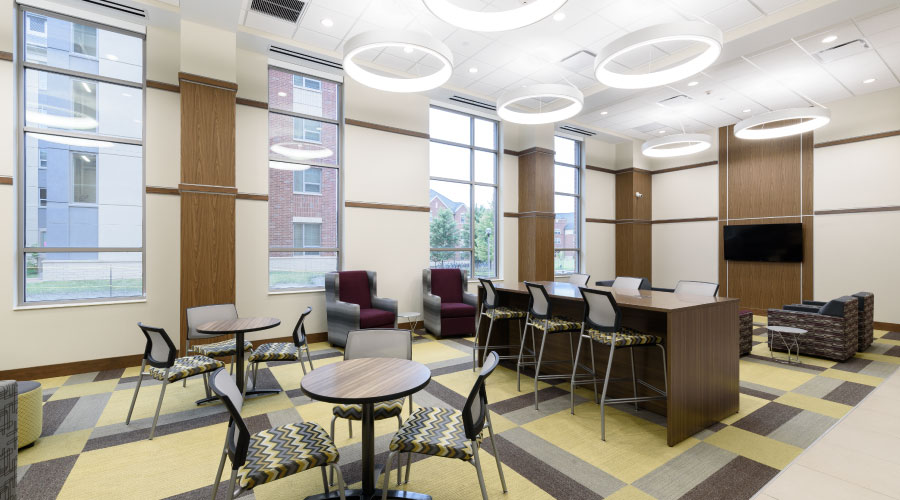How to Optimize Daylighting with Smart Lighting Design, Lighting Controls
From window film to lighting controls, here are some expert-suggested strategies for overcoming daylighting challenges.
To address daylighting challenges, facilities professionals need to “manage how light comes into a building and how it impacts the activities inside,” says Marc Brener, director, renewable and energy efficiency services with Energy Experts International. Infrared and ultraviolet wavelengths streaming through windows, if not managed correctly, can heat building interiors, prompting the air-conditioning systems to cycle on and off to maintain the temperature. That can lead to power spikes and demand charges, and ultimately increased HVAC expense.
Window films are a relatively easy way to reduce the amount of infrared radiation that comes through the window. They can potentially slash the heat that gets through by about 75 percent, Brener says. Moreover, they’re available in different colors, styles, and patterns.
Light sensors installed on the ceilings can monitor the amount of natural daylight entering the room, Brener says. The sensors can be connected to motorized window shades and room light controls to adjust the shades so they allow a certain amount of ambient light to enter a room all day long. The ceiling or room lights also can be automatically controlled to remain off until a minimum amount of ambient light no longer exists, he adds.
Skylights can bring daylight into many areas of a facility, Brener says. That can even include buildings with multiple floors, although it requires the proper permits and design, so that daylighting pathways can be cut throughout it, from the roof down to the main floor, he adds.
One system incorporates GPS technology that tracks the path of the sun across the sky, so it feeds bright, even sunlight into a facility all day. Brener says his firm installed about a dozen in a food manufacturing facility in southern California. “They never turned on the lights all day,” he says, adding that a lens diffuser attached to the interior ceiling cutout allowed the system to produce an even, steady bright light.
Tying motorized shades into the daylighting control systems is another way to address glare and heat gain.
Luminaire lighting controls
Until recently, daylight harvesting generally was processed through a central lighting control system, says Seth Ely, senior lighting designer with Stantec. “You had to program each sensor and each lighting control zone.”
Luminaire lighting controls, in contrast, incorporate sensors within each fixture; these are paired with microprocessors that allow for a certain level of programming at the device itself, Ely says. “Rather than having a big, central controller that’s on a computer in the facility manager’s office, this allows lighting controls to be distributed.” In addition, because the daylight sensors also can incorporate occupancy sensors, they can turn off or dim lights by areas within a floor, rather than all at once, he adds.
Having a sensor on each fixture leads to better daylight harvesting, because it’s more precise. Just the lights that truly need to be on, are Ely says.
In addition, these types of luminaire-level controllers typically use wireless systems to communicate from the sensor pod to the control system, Ely says. That typically lowers the costs of installation and allows for flexibility in making future changes.
Some also contain Bluetooth beaconing capabilities through built-in transceivers that send and receive radio signals. “This leverages the prevalence of lighting throughout the space in buildings,” Ely says. For instance, the Bluetooth beacons could be used for asset tracking by communicating with tags affixed to each wheelchair or storage cart, he adds.
These technologies also gather occupancy data that can help managers understand how their facilities are being used, and then make changes to optimize efficiency and ultimately costs. For instance, if the system shows a conference room was used a handful of times over the course of a year, it might make sense to repurpose it.
Karen Kroll, a contributing editor for Building Operating Management, has written extensively about real estate and facility issues.
Daylighting market grows
The global market for daylighting systems will reach $340 billion by 2025, according to Arizton, a market research firm. This represents a compound annual growth rate of more than six percent from 2019 to 2025.
he drivers behind this forecasted growth include a rising emphasis on environmental sustainability and a desire to reduce energy consumption in both commercial and residential buildings, as well as regulations on energy efficiency.
Related Topics:













